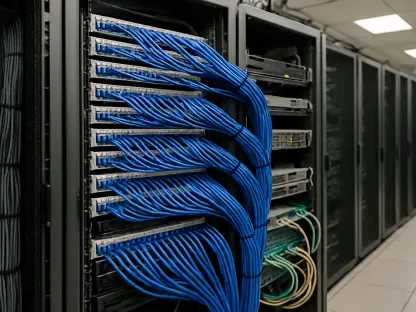The semiconductor industry is witnessing a significant shift as Arm, the UK-based chip designer, transitions from its historical role as a supplier of chip designs to becoming a direct seller of its own chips. This move marks a major change in Arm’s business model and has implications for its relationships with long-standing partners and competitors in the industry. Traditionally, Arm has been known for licensing its chip designs to major semiconductor firms, but now it is stepping into the silicon market with its own products, potentially destabilizing existing partnerships and reshaping power dynamics within the semiconductor industry.
Arm’s Strategic Shift
From Licensing to Manufacturing
Historically, Arm maintained a unique position within the semiconductor landscape by acting as a neutral supplier of intellectual property, providing chip designs that firms such as Qualcomm, Nvidia, Intel, and AMD used to manufacture their own chips. This business model established Arm as a cornerstone of the industry, allowing it to influence technology development while avoiding direct competition with its customers. However, the company is now entering uncharted territory by launching its own line of chips. This strategic shift to manufacturing and selling semiconductors signifies a bold move that could alter the balance of power within the industry, as it could challenge the dominance of long-established manufacturers.
As Arm transitions into manufacturing, the company is adopting a business model commonly seen in other fabless chip entities such as Nvidia. By developing its own silicon products, Arm aims to take advantage of the growing demand for high-performance computing solutions. This move allows Arm to leverage its architectural expertise while outsourcing production to industry-leading foundries like TSMC, effectively reducing capital expenditure related to chip fabrication. Nevertheless, this shift raises questions about the future dynamics between Arm and its long-standing partners, who may now view Arm not just as a supplier but as a direct competitor, impacting the strategic alliances that have long defined the industry.
Securing Major Customers
In a groundbreaking development, Arm has successfully secured Meta (formerly Facebook) as its first major customer for its internally designed server CPUs. This deal marks a critical milestone for Arm as it places the company in direct competition with established industry giants like Qualcomm, Nvidia, Intel, and AMD, the traditional leaders in server chip manufacturing. Arm’s initial foray into producing its own semiconductor is expected to target the data center CPU market, a sector historically dominated by x86-based architectures from companies like Intel and AMD. If Arm’s server CPUs prove successful, they could significantly disrupt this entrenched ecosystem.
Arm’s securing of Meta as a customer serves as a powerful endorsement of its new strategy, signaling the company’s ability to compete at the highest levels of the industry. This partnership shows that Meta has sufficient confidence in Arm’s ability to deliver high-performance server CPUs tailored for data center applications. Additionally, this venture highlights a significant shift from Arm’s previous role as a neutral supplier of intellectual property to a company actively participating in the silicon market. However, this move also introduces complexities for enterprise customers who might now see their chip design supplier as a direct competitor, potentially impacting future business decisions and partnerships within the semiconductor industry.
Implications for the Semiconductor Industry
Direct Competition with Long-Standing Partners
Arm’s entry into the data center CPU market signals a direct challenge to its largest customers, including Qualcomm, which has also been vying for deals with Meta to supply processors based on Arm’s architecture. This transition could raise concerns among enterprise customers who now face the potential reality of competing with their chip design supplier. The impact of this shift cannot be understated, as it moves Arm from a neutral entity in the semiconductor ecosystem to an active competitor. The deal with Meta underscores Arm’s intent to establish itself as a formidable player in the market, a position that contrasts sharply with its long-held role as a design licensor.
This transformation in Arm’s role presents complex scenarios for its existing partners. Companies that have relied on Arm’s designs might now perceive a competitive threat, leading to potential friction in previously smooth relationships. Moreover, enterprise customers may need to reevaluate their dependency on Arm’s architecture, especially given the increased competition within the server CPU landscape. This shift could lead to an industry where former allies are now competitors, further complicated by the strategic adjustments companies must make to stay competitive in an evolving market.
Recruitment of Industry Talent
Emphasizing the depth of its strategic transformation, Arm has been actively recruiting top-tier talent from its own licensee companies. This move is intended to bolster the company’s capabilities beyond processor architecture design, expanding into the realm of selling its own silicon. By hiring executives and key personnel experienced in high-performance computing and AI-powered data center chips, Arm aims to strengthen its position in these burgeoning market segments. This strategy not only enhances Arm’s internal expertise but also signals its serious commitment to developing and marketing its own semiconductor products.
These recruitment efforts align with the business models of other leading fabless chip companies like Nvidia, which has successfully combined in-house design with outsourced manufacturing. By bringing in experts from companies that have previously licensed its technology, Arm gains valuable insights into industry practices and strengthens its competitive edge. This strategic hiring demonstrates Arm’s dedication to transforming from a licensor of intellectual property to a direct competitor in the silicon market, further solidifying its ambitions to disrupt established players in the semiconductor industry.
Expansion into AI and High-Performance Computing
AI Hardware and the Stargate Initiative
Arm’s accelerated push into AI hardware presents a significant challenge to Nvidia, which currently holds a dominant position in the AI-specific GPU market. Together with its parent company SoftBank, Arm is a key participant in the Stargate initiative, a project aimed at developing AI-focused data centers in the United States in collaboration with OpenAI and Oracle. Through this initiative, Arm aims to create cutting-edge AI hardware that can power the next generation of data centers. This move is particularly timely as the demand for AI chips is escalating rapidly, driven by advancements in generative AI and other high-performance computing applications.
The Stargate initiative highlights Arm’s aggressive strategy to disrupt Nvidia’s current stronghold on AI GPUs. By joining forces with notable entities like OpenAI and Oracle, Arm is positioning itself at the forefront of AI hardware development. This collaboration not only showcases Arm’s commitment to innovation but also emphasizes its intent to capture a significant share of the growing AI market. The importance of this endeavor cannot be overstated, as successful AI chips could propel Arm into a leading position within the highly competitive AI hardware arena, thereby challenging Nvidia’s supremacy in this crucial sector of the semiconductor industry.
Collaboration with Broadcom
In addition to its efforts within the Stargate initiative, Arm and SoftBank are partnering with Broadcom to develop a custom-built AI chip specifically for SoftBank’s data centers. This collaboration is poised to generate significant revenue while exemplifying Arm’s commitment to expanding beyond traditional IP licensing into direct competition with established semiconductor giants. By working with Broadcom, Arm leverages its expertise in architecture design alongside Broadcom’s robust capabilities in semiconductor production, aiming to create highly specialized AI chips tailored for high-performance computing and data center applications.
The project with Broadcom reflects Arm’s broader ambition to compete in sectors historically dominated by other semiconductor leaders. This collaboration signifies Arm’s proactive approach in establishing itself as a key player within the AI hardware market, a move that underscores its dedication to innovation and market expansion. As Arm continues to pursue such high-profile partnerships, it demonstrates the company’s strategic vision to diversify its portfolio, enhance its market position, and compete head-to-head with industry giants in high-performance computing and AI-driven applications.
Potential Challenges and Industry Reactions
Regulatory and Competitive Concerns
As Arm continues to expand its direct chip sales, there are potential regulatory and competitive concerns that need to be addressed. The dual role of being both a supplier of intellectual property and a direct competitor in the chip market introduces complex dynamics that could attract antitrust scrutiny. Regulators may require clear separation between Arm’s IP licensing and its chip manufacturing divisions to avoid any perceived preferential treatment or sudden fee hikes for licensing. Such regulatory measures might be necessary to ensure a level playing field within the semiconductor industry and to maintain healthy competition among market participants.
The evolution of Arm’s business model could also lead to competitive concerns among enterprise customers. Companies that relied on Arm’s designs might now face the prospect of competing with their former supplier, leading to strategic reevaluations and potential adjustments in their technology roadmaps. Despite these challenges, Arm’s established ecosystem provides a substantial barrier to immediate shifts away from its technology. However, the long-term implications of Arm’s new strategy could prompt companies to explore alternatives and mitigate risks associated with depending on a supplier that is also a competitor in the semiconductor market.
Industry Response and Alternatives
While a short-term mass migration away from Arm’s architecture seems improbable due to the established ecosystem and the complexities involved in shifting to new architectures, some companies are already exploring alternatives. For instance, Qualcomm has been considering RISC-V as a potential replacement for Arm’s designs. This open-source architecture offers an alternative that companies could develop in-house, reducing reliance on Arm and potentially avoiding competitive conflicts. Similarly, other firms are making in-house efforts to diversify their design capabilities and reduce their dependency on Arm’s intellectual property.
Despite these potential transitions, Arm remains a crucial architect in the semiconductor industry. Differentiation within the market largely occurs at the System on Chip (SoC) design level, where each company can add unique features and optimizations. Arm’s extensive ecosystem, established partnerships, and proven technology offer compelling reasons for existing customers to continue their reliance. Nevertheless, the evolving competitive landscape and Arm’s new role as a direct market player may compel industry participants to carefully assess their strategic positions and consider diversifying their technology stacks to maintain competitiveness and mitigate potential risks in the future.
Future Outlook
Impact on Supply Chain Strategies
As Arm’s transition into direct sales continues to unfold, it has the potential to significantly alter supply chain strategies throughout the semiconductor industry. Companies that once viewed Arm purely as a partner providing intellectual property may now see it as a rival that is actively competing for market share. This perception shift could lead to a reevaluation of existing partnerships and a reconsideration of reliance on Arm’s technology. Business strategies and supply chain dynamics may need to be realigned to address the new competitive landscape introduced by Arm’s entry into chip manufacturing.
The long-standing relationships between Arm and its partners are likely to experience considerable strain, necessitating new approaches to collaboration and competition. The impact on supply chain strategies could be profound, with companies exploring alternative architectures and suppliers to mitigate risks posed by Arm’s newfound dual role. As the industry adapts to these changes, the traditional dynamics of the semiconductor market may be reshaped, leading to new alliances, diversified technology strategies, and potentially transformative shifts in how semiconductor firms interact and compete on a global scale.
Evolving Dynamics and Unanswered Questions
The semiconductor industry is currently experiencing a substantial transformation as Arm, a well-known UK-based chip designer, transitions from its traditional role as a provider of chip designs to becoming a direct seller of its own chips. This strategic shift represents a major evolution in Arm’s business model and could significantly impact its long-lasting relationships with industry partners and competitors. Historically, Arm earned its reputation by licensing its cutting-edge chip designs to major semiconductor companies. However, in a bold move, Arm is now entering the silicon market with its own product line. This development has the potential to disrupt existing partnerships and alter the balance of power within the semiconductor sector. By directly selling its chips, Arm is stepping into territory that could create tension with companies that have relied on its designs, while also challenging competitors who already operate in the silicon market. This shift indicates a new phase in Arm’s growth and a possible reshaping of industry dynamics.









